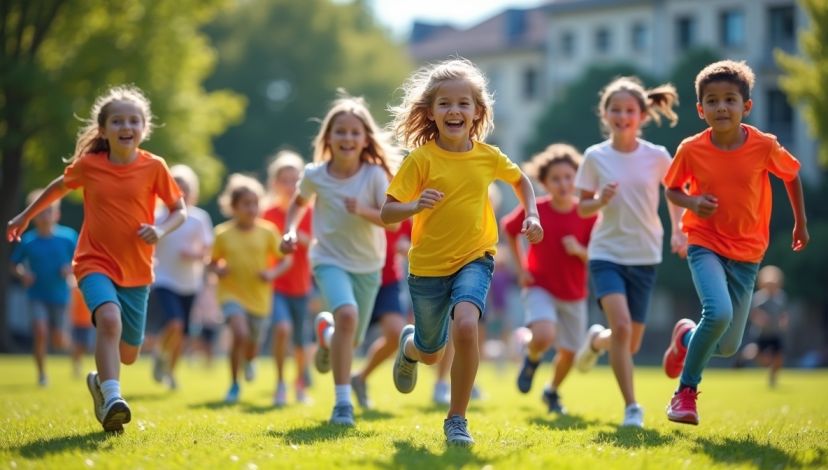Explain Why There Is A Growing Concern Over The Physical Fitness Of Children And Adolescents

Over the past few years, increased attention has focused on the physical fitness of youngsters and younger people. This concern stems from the noticeable drop in physical activity among the youth and the rise of health issues linked to inactivity. Children now spend more time engaging with screens indoors and less time playing outside or participating in activities like sports. This transition carries severe implications for their physical and mental well-being, both now and in the future. When we explain why there is a growing concern over the physical fitness of children and adolescents, it becomes clear that encouraging healthier lifestyles is essential for their overall development.
Key Points:
Table of Contents
- What are the major reasons for the deterioration of physical fitness amongst youth?
- How Does Sedentary Lifestyle Explain Why There Is A Growing Concern Over The Physical Fitness Of Children And Adolescents?
- How Does Inactivity Explain Why There Is A Growing Concern Over The Physical Fitness Of Children And Adolescents And Their Long-Term Health Problems?
- What Are Schools and Communities Doing About This Concern?
- Table: Community Environment Impact on Physical Activity
- What Will Help Enhance Physical Fitness When We Explain Why There Is A Growing Concern Over The Physical Fitness Of Children And Adolescents?
- Conclusion
- FAQ’s
- Children are becoming more sedentary instead of playing.
- Poor nutrition, combined with inactivity, aggravates health outcomes.
- Schools and even communities are unable to offer such opportunities to individuals in respect to physical activities.
What are the major reasons for the deterioration of physical fitness amongst youth?
Today, deterioration of the physical fitness in children and teens has a number of reasons. Technology induced sedentary lifestyles are one of the major ones. Children are on the smartphones, tablets, and video games 7.5 hours a day and have less time to play and engage in sport activities outside. Also, many schools have reduced recess and physical education due to budget cuts and an academic-focused education, limiting opportunities for physical activity.
Improper eating habits contribute too. Marketing and easy access to processed snacks, sugary drinks, and fast food cause unhealthy eating habits. The high consumption of calories without corresponding loss in an active way and particularly those foods with low nutritive value result in weight gain and risks of diabetes – type 2 and high blood pressure.
Further, there are certain communities (particularly the low-income ones) which do not have safe parks, sidewalks, and recreational facilities in place. Children have to do sports less due to the lack of safe areas to move about, therefore it is more difficult to raise the level of youth fitness even knowing its necessity.
How Does Sedentary Lifestyle Explain Why There Is A Growing Concern Over The Physical Fitness Of Children And Adolescents?
Kids nowadays have a sedentary lifestyle that is harmful to their well-being. On a physical level, absence of exercise makes muscles, bones, and the cardiovascular endurance weak. Long periods of sitting may lead to a bad posture and predisposition to obesity. According to the Centers for Disease Control and Prevention (CDC), sedentary behavior is a predisposing factor itself of developing chronic illnesses, such as heart disease and diabetes type 2.
In addition to physical effects, sedentary activity increases anxiety, depression, and reduces self-esteem. Exercise causes the release of endorphins, which improves mood and relieves stress, which deprived children of inactivity do not enjoy. Physical fitness contributes to improved concentration and thinking abilities a child will have in his studies, therefore, more inactive children can perform worse in school.
Case Study: A child with hundreds of hours spent playing video games is likely to grow overweight, fatigued, and unable to pay attention unlike his/her physically active counterpart. This example demonstrates that the lack of physical activity has the competence to affect various spheres of child life, including well-being, learning, and health.
How Does Inactivity Explain Why There Is A Growing Concern Over The Physical Fitness Of Children And Adolescents And Their Long-Term Health Problems?
The effects of bad health due to poor physical fitness occur especially as early as during old age. The inactive overweight-children develop the adult diseases way earlier than it has been in its predecessors. These are high blood pressure or hypertension, high cholesterol levels, insulin resistance, and joint problems. Constant tiredness and lower backache are also frequent complains.
Specialists predict that this generation may live shorter lives than their parents if current trends continue. Such a decline has never occurred in contemporary history, making the physical fitness of youth a serious concern. Early intervention can reduce the risk of lifelong health issues and improve quality of life.
What Are Schools and Communities Doing About This Concern?
Schools and communities have been rightfully labeled as having an important role in enhancing physical fitness, but there are numerous obstacles that present themselves to them. Budgetary constraints or testing program emphasis in schools have led many schools to reduce physical education. Some do not have PE classes every day, or they have reduced the recess period. In the absence of these structured activities, the kids will lack the physical activity essential to them.
The low-income communities, more particularly, the low-income district of the community lackages in safe parks, recreational programs, and playgrounds. This restricts the capability of the children to be active outside school. Much work has been done in trying to increase access to facilities and programs, but the rate has been inconsistent.
Table Physical activity opportunities in schools: A comparison
| Factor | Schools With Adequate PE | Schools With Limited/No PE |
| Daily Physical Education | Yes | No |
| Recess Time | 20+ minutes/day | Reduced or eliminated |
| Access to Sports | Multiple options | Few or none |
| Impact on Fitness | Positive | Negative |
Table: Community Environment Impact on Physical Activity
| Environment Type | Access to Safe Play Areas | Availability of Sports Programs | Effect on Youth Fitness |
| Affluent Neighborhoods | High | Many | Better |
| Low-Income Neighborhoods | Low | Few | Poorer |
What Will Help Enhance Physical Fitness When We Explain Why There Is A Growing Concern Over The Physical Fitness Of Children And Adolescents?
Physical fitness amongst the youths needs a complex method of approach. There is a need to work on creating active families, schools, and communities that promote active lifestyles and healthy eating. Parents should be able to restrict screen usage and encourage physical activities and sports involvement. Even in the face of academic pressure, schools should pay attention to such things as regular physical education and recess.
Societies must contribute towards secure recreational facilities, playgrounds, and low-cost sports activities available to every child. Public health campaigns can help people understand why physical fitness and healthy eating are paramount. Policies can also regulate the marketing of unhealthy food to children, improving diet quality.
Note: The Senate should also promote small incremental changes across daily exercise regimen since long-term improvement on fitness can be realized.
Note: Physical fitness is beneficial to physical and mental health and thus vital to the general health.
Conclusion
The increase in the interest of physical fitness of children and adolescents can be regarded as a severe transformations of youth lifestyle nowadays. Unhealthy lifestyles that consist of eating unwholesome foods and low levels of physical activities are destroying the health of the younger generation. These tendencies raise concerns of worse health and low life expectancy, unless things are rectified without delay.
Knowing the causes and consequences will help us approach children to be more active and healthy. The school, family, and community must work together to ensure the creation of an environment that encourages fitness and well-being. Our children’s lives are at stake.
FAQ’s
Q1: Why do children and adolescents need to be physically fit?
Physical fitness leads to healthy development, the prevention of chronic illnesses, the enhancement of intellectual well-being, and improved grades.
Q2: What is the influence on physical fitness of children due to screen time?
They contribute to inactive lifestyles that lessen exercise level and cause poor health and fitness.
Q3: What are the risk factors of childhood obesity?
Obesity during childhood exposes a person to diabetes, heart diseases, joint pains, and may predispose them to health complications throughout their life.
Q4: What assistance can be rendered by schools to enhance physical fitness among the youngsters?
Daily physical education recesses and encouraging activity and sports can be taught at schools to continuously behave in motion.
Q5: What is the contribution of communities to the fitness of children?
Social networks create free, safe areas and activities where people can physically exercise; this is a key towards the promotion of active lifestyles.
Latest Posts

Chipotle Nutrition – Your go-to guide for calories, healthy choices, and balanced meals at Chipotle.
TOP NEWS
© Copyright 2025 Chipotle Nutrition. All rights reserved












No Comments